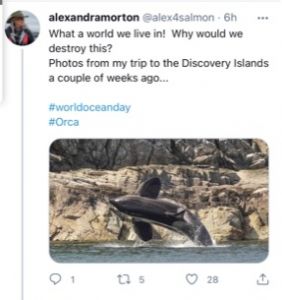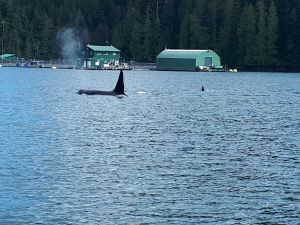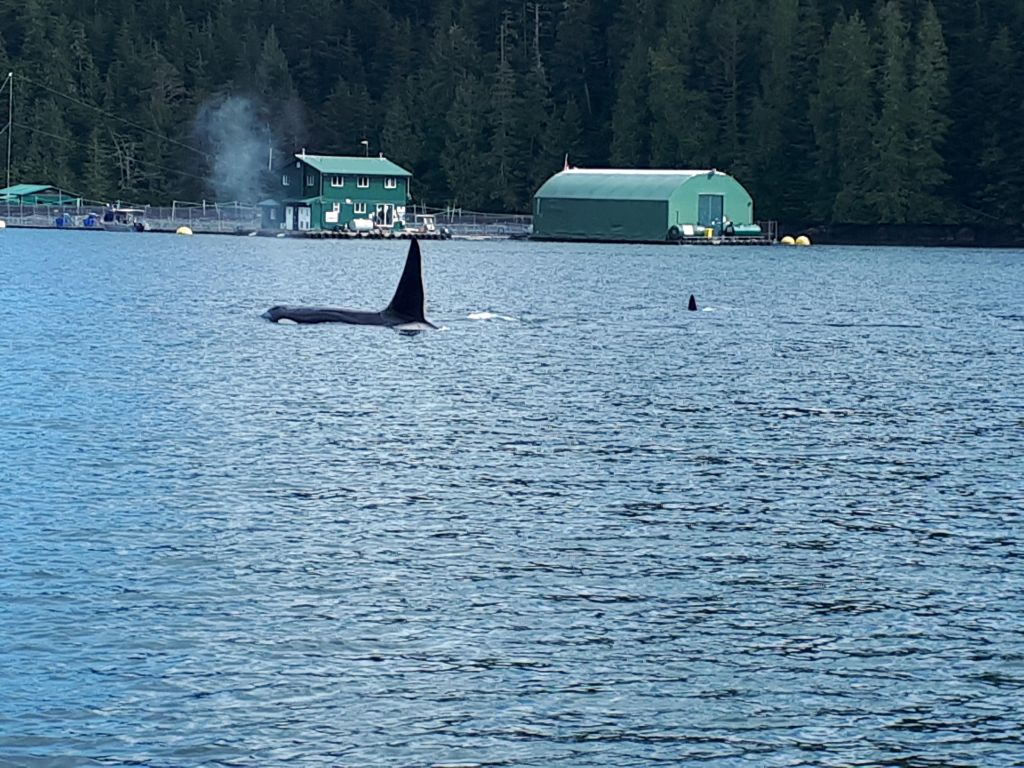A true miracle: It seems that all it needed was a pronouncement that salmon farms around the Discovery Islands should not be restocked for sea lice to vanish from wild fish. According to salmon farming expert Alexandra Morton, there has been a 95% decline in the number of sea lice infecting wild salmon in Okisollo Channel between 2020 and 2021. Ms Morton writes that the channel is the most critical region of the Discovery Island because 1) it is so narrow and 2) most wild salmon coming and going to the Fraser River funnel through it and 3) wild salmon have been exposed to high concentrations of sea lice, bacteria, and viruses from four farms owned by Cermaq, Mowi and Grieg.
It is only a few months since the decision was made to prevent the restocking of these farms but that does not mean that farms throughout the Discovery Islands have all stopped operating as they continue to grow out their current stock. However, I understand she may be correct that the specific sites around Okisollo are not stocked as they would have been in their planned fallow period. Apparently, for many years, the three operating companies have had an agreement that adjacent sites would be kept on the same production cycle. This means that these sites have always undergone a fallow period every 2 years yet, Ms Morton has never found lice free phenomenon during similar past fallow periods.
It will be interesting to see the results of lice counts from those who have undertaken long-term wild fish sampling, especially as those who blame salmon farms for wild fish declines also claim farms have an influence over many kilometres, not just in the immediate vicinity of a farm. In her commentary, Ms Morton shows the location of six sampling sites around the Discovery Islands but only refers to the results from just one, although it’s not clear which one.
Perhaps after all, Ms Morton has observed a true miracle.
Another miracle: Ms Morton has also posted a photo on Twitter of a whale she saw during a recent visit to the Discovery Islands as if this is something different that is happening because salmon farms there are no longer allowed to restock.

The fact that such natural wildlife is present despite the presence of local salmon farms shows that the two can coexist. I was recently sent some photos including the following of whales swimming past a salmon farm.

Clearly, salmon farming and natural wildlife are not mutually exclusive. This is not some miracle that is just happening now.
Out of interest: Since writing this commentary I learned of a new paper by Erin Rechisky and others published in the North American Journal of Fisheries Management. The researchers tracked wild salmon passing through the Discovery Islands. Their findings were that the median residence time for fish passing through the 4 km stretch past three farm sites was 5.9 hours in 2017 and 7.3 hours in 2018. Fish were in the proximity of salmon farms for approximately 4 -11 minutes. These migrating sockeye salmon certainly do not hang about for long.
Kintama Research Services have published some of the data on their website but more interesting, they have posted a simulation of the smolt migration. In is possible to focus in on specific areas including the Discovery Islands and the Okisollo Channel and follow the actual routes the smolts take. This brief visual is certainly worth a watch at http://kintama.com/animator/dep/Chilko2017_sockeye/
Wake up Norway: The Scientist has highlighted that farmed Atlantic salmon have likely passed the piscine orthoreovirus (PRV) to wild Pacific salmon. A new paper in Science Advances demonstrates that PRV was likely to have come from farmed Atlantic salmon in the late 1980s. However, this is not unexpected given that most of the authors of this study have not been previously favourable towards salmon farming.
However, what interested me most about the article in The Scientist was that the comments about the paper were made by Martin Krkosek, a mathematical modeller and ecologist from the University of Toronto who has had a close association with anti-salmon farming activist Alexandra Morton from his days as a research student. Dr Krkosek told The Scientist that the paper shows convincingly that there is a repeated exchange or transmission between wild and domesticated species. He then draws a comparison with Covid and uses the example of salmon farming to suggest that we are creating opportunities for infectious diseases to wreak havoc on people, our health and in this case our natural environment and food production.
As I have pointed out Dr Krkosek is a working colleague of the head of Norway’s Expert Salmon Group and it must surely be of concern that like the claimed transmission of PRV virus between wild and farmed salmon, there is similar transmission of ideas from Dr Krkosek to Norwegian scientists working on the Traffic Light System. Dr Krkosek has previously co-authored papers with Professor Crawford Revie, the head of the international research group chosen to assess the Traffic Light system. When will the Norwegian salmon farming industry wake up and start to see the writing that is on the wall?
Meanwhile, as this Canadian research team ensure that they receive maximum publicity for their work to undermine the salmon farming industry in Canada, the other side of the debate is largely being ignored. For example, PRV was found in Canada in 1977 before the advent of salmon farming and was sourced from wild steelhead trout. This suggests that the virus was not introduced by salmon farmers. More importantly, as a 2017 article in the Vancouver Sun reports ‘millions of Atlantic salmon have been introduced to BC stream since 1905’. The article states that more than eight million Atlantic salmon have been intentionally released into BC rivers and lakes beginning more than a century ago. With the support of the Federal Government, dozens of attempts were made to establish viable Atlantic salmon populations on the west coast from 1905 to 1935. However, Atlantic salmon have not fared well outside their natural range and no spawning populations were ever established. This does not mean that any pathogens carried on these fish did not survive.
Whilst industry critics like Dr Krkosek, who is not a vet or a fish disease specialist, suggest that viruses like PRV threaten the health of wild Pacific salmon, the reality is that controlled challenge laboratory studies show no clinical disease can be produced in wild salmon. In addition, wild salmon hatchery managers have never considered PRV to be a health hazard. PRV was initially highlighted as a problem for wild fish by Alexandra Morton after her attempts to link wild fish declines with sea lice infestations did not bring about the changes she wanted implemented.
An inconvenient truth: I have been sent an interesting article written by retired fisheries biologist Otto Langer, who began working in the Department of Fisheries and Oceans at the end of the 1960s. In the article, Mr Langer asks why Alaska’s Bristol Bay Rivers produce more Sockeye salmon than Canada’s Fraser River. In 2017, Bristol Bay returned about 58 million sockeye, the run in the Fraser River was about 1.5 million fish.
Mr Langer says that despite the Cohen Commission in 2012, sockeye on the Fraser River have been worse off and in 2020 were on the point of collapse. He says that the debate as to what has happened has continued for decades and has gone round in circles. The logging sector blame commercial fishers and in turn the fishers blame the logging and forestry industry. The sports fishers blame the commercial fishers and those from the First Nations. whilst the First Nations blame everyone.
Since the 1970s, conservation groups blamed over-development of the river and the estuary habitats, and this blame merry-go-round has continued every year except when greater than expected returns occur. Mr Langer writes that the Cohen Commission was unable to shed any real light on what was happening in the Fraser, except that over the past couple of decades, there were two new issues to blame – salmon farming and climate change.
Mr Langer says that most parties in the debate have been correct at one time or another but in writing this discussion paper he hopes that by comparing the Bristol Bay sockeye fishery with that of the Fraser River he can provide some partial answer and general observation that anyone can understand. He hopes that his discussion document will put an end to the various debates and denials so that the focus can be directed on addressing the key issues that are assuring the destruction of the Fraser River runs and likely the other forms of life associated with them.
I do not intend to repeat Mr Langer’s lengthy analysis of the two fisheries here as it is his conclusions that are key.
Mr Langer points out that human development can have a significant impact on watersheds and that less than significant changes can have significant harmful alteration of fish habitat and fish populations. He notes that the Fraser River is not unique in this respect and changes can be identified in rivers from the California Mexican border to right along the BC coast. He says that where there is human settlement, excessive fishing pressure and too much human activity in the form of logging, farming, roads, dam, fish farms etc wild salmon are usually one of the first species to suffer. The lack of human development is apparent in Bristol Bay but not in the Fraser Basin.
Mr Langer also highlights that the situation for Fraser River salmon is even more depressing when it comes to climate change. He has no doubt that climate change such as increased water temperature, rising sea level and ocean acidification will continue to impact salmon survival. He does not see that any current planned changes will reverse these global trends and salmon cannot wait.
He also mentions that Government policies can often be very contradictory with approval of high- risk project such as in the middle of an estuary as has happened on the Fraser River. Mr Langer also highlights the large shocks delivered to the Fraser River and its salmon such as the Kenny Dam and its water diversion impacts on river temperature which equals the impact of the Hell’s Gate blockage, the Big Bar Slide, and the use of the Fraser as a waste dumping ground and the never-ending conversion of the estuary into an industrial and shipping corridor.
Mr Langer ends by pointing out that even Bristol Bay is threatened with development from mining and excessive fishing that could bring about the same fate as that of the Fraser Sockeye. He concludes that unfortunately, it seems that little can. or will be done, to change the prevailing conditions in the Fraser River, its estuary, the North Pacific Ocean and in Victoria and Ottawa. This is the inconvenient truth.
Langer, Otto E., 2021. Why Alaska’s Bristol Bay Rivers Produce More Sockeye Salmon than the Fraser River. Canada House of Commons Standing Comm. on Fisheries and Oceans (FOPO), 43 Parliament. 2nd Session, Hearings on the State of the Pacific Salmon Dec 2020 – May 2021. Ottawa, Canada. 15p website: <ourcommons.ca/FOPO-e>
Bluebacks and Silver Brights: This is the title of the memoir of BC fisherman Norman Safarik. It is subtitled – A lifetime in the BC Fisheries – From Bounty to Plunder. The title tells the reader all there is to know about the state of wild catch fisheries in British Columbia. Norman was born in 1918 so worked from just before the second world war and until he retired in his late eighties. He tells about the highs and lows of being involved in wild capture fisheries however, the most interesting part of the book is the appendices especially the copy of the letter he wrote to Dr Peter Pearse, chair of the Commission of Pacific Fisheries in December 1981. It runs to twelve pages of the book but starts off:
British Columbia is one of the largest natural fish hatcheries in the world. Lumber companies, industry and urban development have destroyed the salmonid habitat for more than a hundred years. Commercial fishermen, sportsmen and predators have taken billions of pounds (weight) of salmon in that time and still some salmon are entering most of our streams to spawn. Some creeks are gone forever – filled with industrial sites such as the Hooker Chemical plant on the north shore of the Burrand Inlet. What is gone we cannot weep over at this time, but now we must take inventory of every stream that remains no matter how small it is and drastically improve what we have left to make up for those creeks that are now lost to us forever.
He continues that most of the spawning grounds, even those away from urban areas are devastated and are still being devastated. Unless there is cooperation on salmonoid enhancement it will be impossible to save salmon for even the sports fishermen, much less the commercial fishery. The freshwater systems can be improved to sustain even greater runs of salmon than they normally did at the turn of the century.
Mr Safarik’s comments sound remarkably familiar after reading those written by Mr Langer and these were made forty years ago. This was not long before Alexandra Morton moved to the BC coast. When she started to make her observations of declining wild salmon, she had not been exposed to the long history of plunder and urban development. She seems to have assumed that the declines really started with the advent of salmon farming, and this has been her focus ever since. The reality was, as witnessed by Norman Safarik and is, as highlighted by Otto Langer, that all forms of human development are to blame for wild salmon’s decline. Forty years ago, Mr Safarik implored the authorities to act, and little was done. Now, the Federal Government have responded but their decisions are misplaced. Salmon farming in the Discovery Islands is to take the rap for many years of the inaction of others. Removing salmon farms will not bring back wild salmon to the Fraser River. This is the reality.
Postscript: Alexandra Morton has told I-politics that the Government must listen to the scientists to protect wild fisheries. However, what she really means is that the Government should only listen to those scientists who support Ms Morton’s views.
She says that government scientists recommended protective measures to rescue the Fraser River steelhead, they were ignored. This is not surprising given that government must balance the science with the economic impacts of any measures. The same happens every year when the EU set fishery quotas. Some scientists might argue that fishing should be stopped to give stocks time to recover but at the same time, the economic implications for the fishery communities must be considered.
Some government scientists suggest that PRV ruptures the red blood cells of wild salmon which is why salmon of farmed origin that supposedly have the virus should not be transferred into sea pens. However, according to the latest research PRV was first transferred to BC during the 1980s. In theory, if this narrative is to be believed, then wild salmon must have been dying from the effects of PRV since then. Yet, according to Ms Morton’s narrative, it was sea lice that was killing wild salmon then and now it is PRV. I can only wonder that Ms Morton is simply changing her narrative to gain maximum publicity.
I-Politics says that DFO Dr Kristi Miller told the Fisheries & Oceans Committee that salmon are suffering multiple stressors and even if one can be reduced then survival can be boosted. She pointed to the heat stress young sockeye now endure in the Salish Seas before they reach the Discovery Islands where they are exposed to additional stressors. She said that heat stressors cannot be removed but in the short-term moving salmon farms removes the stressors of sea lice, PRV and mouth rot.
This is a view that is repeated everywhere salmon are farmed. There are many stressors affecting wild salmon but the simplest to address, even if it is the least impactful, is to move salmon farms. We have known about the other stressors for many years but nothing much has been done about them because it is so much easier to just blame salmon farmers.

